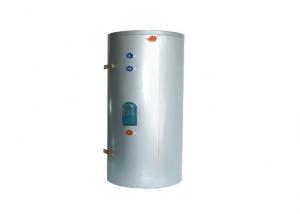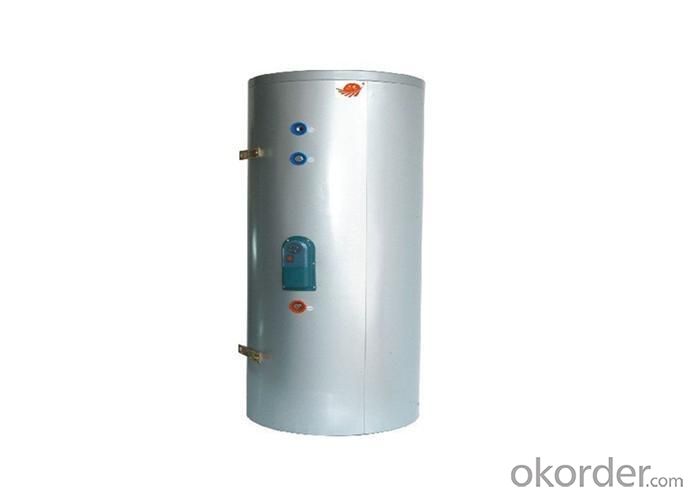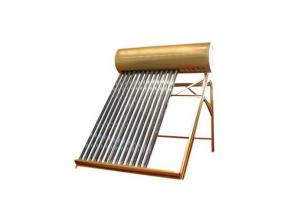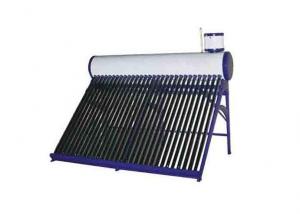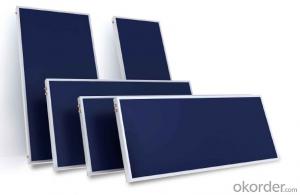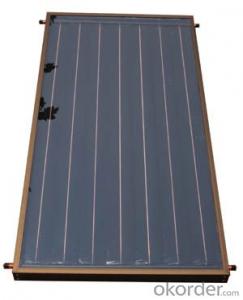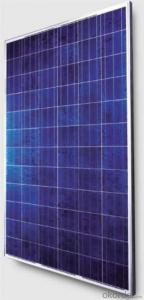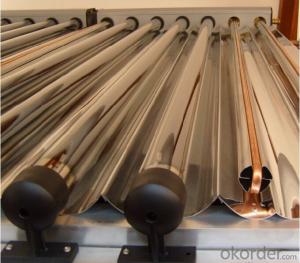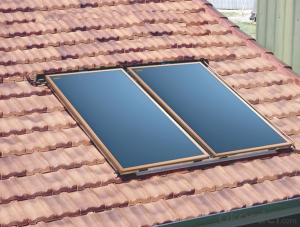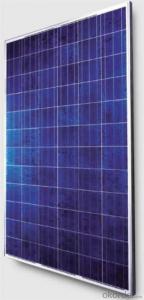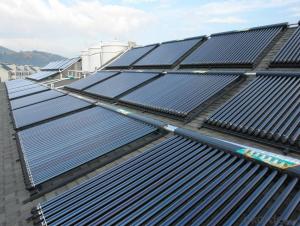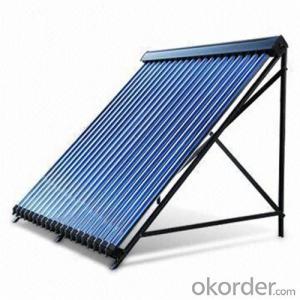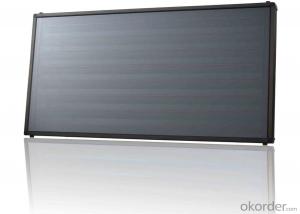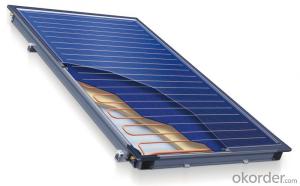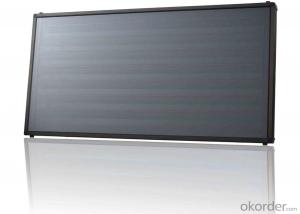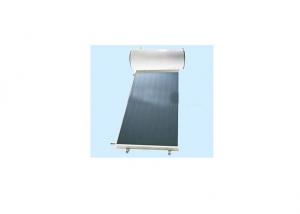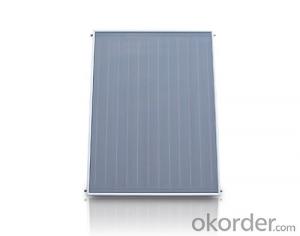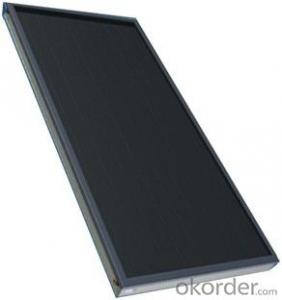Sunmaxx Solar Collectors Split Pressurized Water Tank
- Loading Port:
- China Main Port
- Payment Terms:
- TT or LC
- Min Order Qty:
- 2 Sets set
- Supply Capability:
- 1000 Sets per Month set/month
OKorder Service Pledge
OKorder Financial Service
You Might Also Like
Match with solar collector perfectly
High water heating efficiency
Good hot water preservation
Features:
1. Perfect hot water temperature preservation.
2. Matching with pressrized solar collector plays high solar energy absorption efficiency.
3. One copper coil tank, double copper coils tank, three copper coils tank are available.
Capacity (Liter) | Inner tank Thickness&diameter (mm) | Insulation Layer (mm) | Outer tank Thickness&Diameter&Height |
100L | φ1.2/Φ370 | 50 | φ0.55/Φ470/h1110 |
150L | φ1.2/Φ370 | 50 | φ0.55/Φ470/h1520 |
200L | φ1.5/Φ470 | 45 | φ0.55/Φ560/h1320 |
250L | φ1.5/Φ470 | 45 | φ0.55/Φ560/h1620 |
300L | φ1.5/Φ470 | 50 | φ0.55/Φ560/h1870 |
400L | φ2.0/Φ600 | 50 | φ0.55/Φ700/h1630 |
500L | φ2.0/Φ600 | 50 | φ0.55/Φ700/h1920 |
- Q: Can solar collectors be used for generating electricity on warehouses?
- Yes, solar collectors can be used for generating electricity on warehouses. By installing solar panels on the roof of a warehouse, sunlight is captured and converted into electrical energy through photovoltaic cells. This enables the warehouse to generate clean and renewable electricity, reducing its reliance on traditional energy sources and lowering greenhouse gas emissions.
- Q: Can solar collectors be used in all climates?
- Solar collectors can be used in all climates, although their efficiency may vary depending on the amount of sunlight available in each climate.
- Q: Can solar collectors be used for heating botanical gardens?
- Yes, solar collectors can be used for heating botanical gardens. Solar collectors can harness the sun's energy to provide heat for various purposes, including heating greenhouse structures in botanical gardens. This sustainable and cost-effective solution can help maintain optimal temperature conditions for plants and create a conducive environment for their growth.
- Q: How much space is required to install solar collectors?
- The space required to install solar collectors can vary depending on the type and size of the collectors, as well as the specific solar energy needs of a property. In general, rooftop solar collectors typically require a few hundred square feet of unshaded space, while ground-mounted systems may require larger areas of land. It is best to consult with a professional solar installer to determine the exact space requirements for a specific installation.
- Q: Can solar collectors be used in wave energy converters?
- Solar collectors cannot be utilized directly in wave energy converters. The purpose of solar collectors is to seize sunlight and transform it into thermal or electrical energy. Conversely, wave energy converters are exclusively engineered to exploit the kinetic energy of ocean waves. The mechanisms and technologies employed in these two energy conversion systems differ significantly, rendering them incompatible with one another. Solar collectors are better suited for solar power generation, whereas wave energy converters are specifically designed for wave power generation, capitalizing on the uninterrupted motion of the ocean to generate electricity.
- Q: Can solar collectors be used for heating swimming pools in colder climates?
- Yes, solar collectors can be used for heating swimming pools in colder climates. Solar collectors are designed to harness sunlight and convert it into heat energy, which can effectively raise the temperature of a swimming pool. While colder climates may have less sunlight available compared to warmer regions, solar collectors can still be utilized to heat swimming pools by capturing and utilizing the available solar energy. Additionally, using solar collectors for pool heating can be cost-effective and environmentally friendly compared to traditional heating methods.
- Q: Can solar collectors be used in coal-fired power plants?
- Yes, solar collectors can be used in coal-fired power plants. Coal-fired power plants primarily use fossil fuels such as coal to generate electricity. However, integrating solar collectors into these facilities can help reduce the overall carbon footprint and enhance energy efficiency. Solar collectors can be employed in various ways within coal-fired power plants. One method is using solar thermal collectors to preheat the feedwater before it enters the boiler. This preheating process reduces the amount of fuel needed to heat the water to steam, resulting in reduced coal consumption and lower emissions. Another approach is utilizing solar photovoltaic (PV) panels to generate electricity alongside the coal-fired power plant. This additional solar power can supplement the electricity produced by burning coal, reducing the reliance on fossil fuels and decreasing greenhouse gas emissions. Implementing solar collectors in coal-fired power plants can also help in reducing operational costs. By utilizing solar energy, the plant can decrease the amount of coal needed, which can result in potential cost savings over time. Furthermore, integrating solar collectors into coal-fired power plants can serve as a transitional measure towards a cleaner and more sustainable energy system. As the world moves towards renewable energy sources, incorporating solar technology into existing coal-fired power plants can be a stepping stone towards a greener future. In conclusion, solar collectors can indeed be used in coal-fired power plants to enhance energy efficiency, reduce emissions, and decrease operational costs.
- Q: Can solar collectors be used in combination with other renewable energy sources?
- Yes, solar collectors can be used in combination with other renewable energy sources. This combination, known as hybrid renewable energy systems, can help increase overall energy production and improve reliability. For instance, solar collectors can be integrated with wind turbines or hydroelectric power to create a more balanced and continuous energy supply, maximizing the utilization of renewable resources. Additionally, combining solar collectors with other renewable sources allows for better energy management and storage options, enhancing the overall efficiency and sustainability of the system.
- Q: Can solar collectors be used in cloudy weather?
- Yes, solar collectors can still be used in cloudy weather. While their efficiency may be reduced compared to sunny conditions, solar collectors can still convert sunlight into usable energy even when it is cloudy.
- Q: Can solar collectors be used in hydroelectric power plants?
- Solar collectors and hydroelectric power plants serve different purposes and operate on different principles, preventing their direct use together. Solar collectors are specifically designed to convert solar energy into thermal energy, typically for heating water or generating electricity through solar thermal power generation. On the other hand, hydroelectric power plants generate electricity by utilizing the kinetic energy of flowing or falling water to drive turbines. However, there are instances where solar energy can be combined with hydroelectric power. For instance, solar energy can power various auxiliary systems in a hydroelectric power plant, such as lighting, sensors, or control mechanisms. By doing so, the overall energy consumption of the plant can be reduced, leading to improved efficiency. Furthermore, solar power can also be integrated with pumped-storage hydroelectric power plants. These plants store excess energy by pumping water from a lower reservoir to a higher one during times of low demand. Later, when demand is high, the stored water is released to generate electricity. During the low-demand periods, solar energy can be used to power the pumps, decreasing reliance on the grid and creating a more sustainable operation. To summarize, even though solar collectors cannot be directly used in hydroelectric power plants, solar energy can still contribute to their efficiency and support auxiliary systems. Additionally, the integration of solar power with pumped-storage hydroelectric power plants can result in a more sustainable and efficient energy system.
1. Manufacturer Overview
| Location | Zhejiang, China |
| Year Established | 2004 |
| Annual Output Value | US$10 Million - US$50 Million |
| Main Markets | North America South America Eastern Europe Southeast Asia Africa Oceania Mid East Eastern Asia Western Europe |
| Company Certifications | ISO 9001:2000 ;CE ;Solar Keymark |
2. Manufacturer Certificates
| a) Certification Name | |
| Range | |
| Reference | |
| Validity Period |
3. Manufacturer Capability
| a) Trade Capacity | |
| Nearest Port | Shanghai,Ningbo |
| Export Percentage | 51% - 60% |
| No.of Employees in Trade Department | 6-10 People |
| Language Spoken: | English, Chinese |
| b) Factory Information | |
| Factory Size: | 10,000-30,000 square meters |
| No. of Production Lines | Above 10 |
| Contract Manufacturing | OEM Service Offered Design Service Offered Buyer Label Offered |
| Product Price Range | Average |
Send your message to us
Sunmaxx Solar Collectors Split Pressurized Water Tank
- Loading Port:
- China Main Port
- Payment Terms:
- TT or LC
- Min Order Qty:
- 2 Sets set
- Supply Capability:
- 1000 Sets per Month set/month
OKorder Service Pledge
OKorder Financial Service
Similar products
Hot products
Hot Searches
Related keywords
